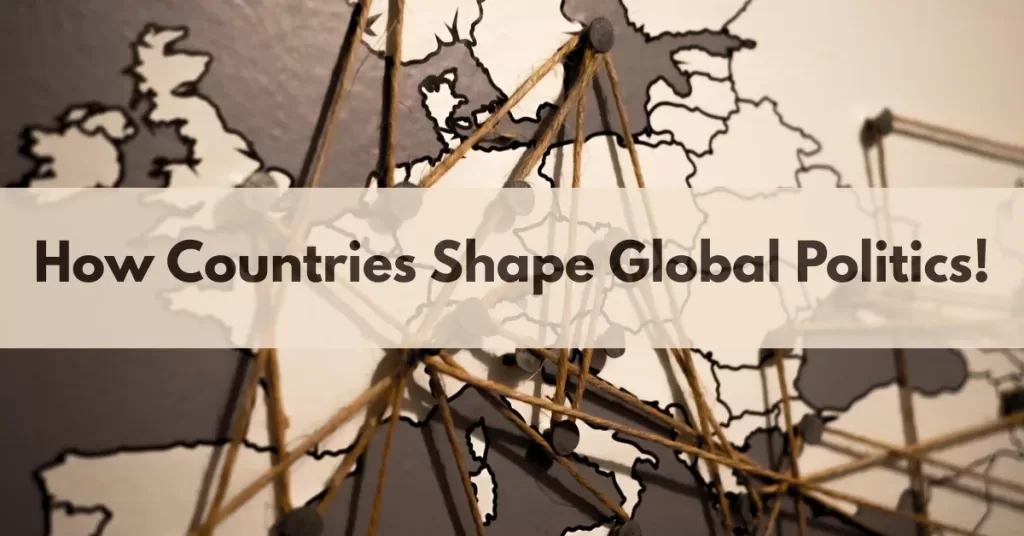Have you ever wondered why some countries form alliances while others engage in conflicts? Or why do global institutions like the United Nations influence world politics?
If you have, then you’ve already begun exploring the fascinating field of International Relations (IR). Today, we are diving into the Theories of International Relations, the guiding frameworks that help us understand how nations interact on the global stage.
Imagine you are playing a strategic board game with different players, each with unique goals, strategies, and resources. Some players form alliances, some seek dominance, while others prioritize trade and diplomacy.
Just like this game, the world of international politics operates under different principles, and IR theories help us make sense of these dynamics.
Must Read- Meaning, Nature and Scope of International Relations
Understanding the Theories of International Relations
Theories of International Relations provide structured explanations for global events, diplomatic relationships, and power dynamics. Scholars and policymakers use these theories to analyze conflicts, trade relations, international organizations, and global cooperation (Waltz, 1979).
Broadly, these theories are categorized into three major schools of thought:
- Realism
- Liberalism
- Constructivism
Each theory offers a unique lens to examine international affairs and understanding them can help us better interpret global politics.
Realism: The Struggle for Power
Think about a historical empire expanding its territory through conquests. This expansion reflects the core idea of Realism, which argues that international relations are driven by power and self-interest (Morgenthau, 1948).
Key Principles of Realism
- The international system is anarchic: There is no central authority to enforce rules.
- States are the primary actors: Governments prioritize their national interest and survival.
- Power determines relations: Stronger nations dominate weaker ones to maintain security and influence.
Example of Realism in Action
The Cold War (1947-1991) between the United States and the Soviet Union is a classic example. Both superpowers sought to maximize their military and political influence, fearing that the other would gain dominance (Mearsheimer, 2001).
Realism explains why nations invest heavily in defense and form military alliances like NATO to secure their interests.
Must Read- Realism in International Relations- 6 Principles
Liberalism: Cooperation Over Conflict
Now, imagine a world where countries cooperate for mutual benefit. This is the essence of Liberalism, which believes that states can work together through diplomacy, international institutions, and economic interdependence (Keohane & Nye, 1977).
Key Principles of Liberalism
- International cooperation is possible: Organizations like the United Nations promote peace and stability.
- Economic interdependence reduces conflicts: Trade relations encourage peaceful coexistence.
- Democratic governments foster peace: Democracies are less likely to go to war with each other (Doyle, 1986).
Example of Liberalism in Action
The formation of the European Union (EU) demonstrates liberalism in practice. After World War II, European nations decided to integrate their economies and establish political cooperation, reducing the chances of future conflicts.
Liberalism explains why diplomatic negotiations, free trade agreements, and human rights advocacy play crucial roles in global governance.
Constructivism: The Power of Ideas and Identity
Now, think about how cultural beliefs and historical narratives shape a country’s foreign policy. Unlike Realism and Liberalism, Constructivism focuses on ideas, identity, and social norms as key drivers of international relations (Wendt, 1992).
Key Principles of Constructivism
- International relations are shaped by beliefs and identities: Nation’s act based on shared values and historical experiences.
- Social norms evolve over time: What is acceptable today might not be tomorrow.
- States construct their realities: Political ideologies and national identities influence foreign policy decisions.
Example of Constructivism in Action
Germany and Japan, once aggressive military powers in World War II, have redefined their national identities as advocates of peace and diplomacy. Their modern foreign policies are shaped by past experiences and societal expectations.
Constructivism explains why global norms on human rights, environmental protection, and nuclear disarmament continue to evolve.
Must Read- Constructivism in International Relations Explained!
Other Notable Theories of International Relations
Apart from the three main theories, scholars have proposed additional perspectives to understand international affairs:
1. Marxism
This theory examines the influence of economic structures and class struggles on international relations. It argues that capitalist nations exploit weaker states to maintain economic dominance. According to Marxist scholars like Immanuel Wallerstein (1974), global politics is shaped by a core-periphery system where wealthy nations benefit at the expense of poorer ones.
2. Feminism
Feminist IR theory highlights the underrepresentation of women in global decision-making and critiques the gendered nature of international relations. Scholars like Cynthia Enloe (1990) argue that traditional IR theories overlook the role of women in peacebuilding, war, and diplomacy. Feminism calls for more inclusive global governance.
3. Postcolonialism
This theory examines the lasting impact of colonial history on modern international relations. Thinkers like Edward Said (1978) argue that Western perspectives continue to dominate global politics, often marginalizing voices from the Global South. Postcolonialism seeks to challenge these power imbalances and promote decolonized narratives in international studies.
4. English School
The English School blends elements of realism and liberalism, focusing on the idea of an international society where states coexist through shared norms and institutions. Scholars like Hedley Bull (1977) suggest that while global politics is competitive, diplomatic customs and legal agreements create a degree of order.
5. Green Theory
This emerging perspective examines the role of environmental issues in international relations. Scholars argue that climate change, resource scarcity, and ecological sustainability should be central concerns in global governance.
Each of these theories offers a unique perspective, enriching our understanding of international affairs.
Conclusion
There is no single “correct” theory of international relations. Different perspectives offer different insights, and real-world events often combine elements from multiple theories.
Think about international relations as a puzzle—each theory provides a piece that helps complete the picture. Some events might align with Realism’s power struggle, while others showcase Liberalism’s cooperation or Constructivism’s emphasis on identity.
Next time you read about global conflicts, trade agreements, or diplomatic summits, try analyzing them through these theories. You’ll start to see patterns in international relations that were once invisible.
So, which theory do you think best explains today’s world? Let’s discuss in the comments!
Frequently Asked Questions (FAQs)
1. What is the most widely accepted theory of International Relations?
There is no single dominant theory, as each one explains different aspects of global politics. However, Realism and Liberalism are the most widely studied and applied in international policymaking.
2. Can a country follow multiple theories at the same time?
Yes, in reality, countries often blend elements of different theories depending on the situation. For example, the United States may act through Realism in military affairs while promoting Liberalism in trade and diplomacy.
3. Why do we need theories of International Relations?
Theories help us make sense of international events, predict behaviors of nations, and guide policymakers in making informed decisions.
4. How does Constructivism differ from Realism and Liberalism?
Constructivism focuses on social identities, beliefs, and norms, whereas Realism and Liberalism emphasize power and cooperation, respectively.
5. What role do international organizations play in IR theories?
International organizations like the UN and WTO align with Liberalism by promoting cooperation and reducing conflicts through diplomacy and economic integration.
References
- Doyle, M. (1986). Liberalism and World Politics. American Political Science Review.
- Keohane, R. O., & Nye, J. S. (1977). Power and Interdependence. Harvard University Press.
- Mearsheimer, J. J. (2001). The Tragedy of Great Power Politics. W.W. Norton & Company.
- Morgenthau, H. J. (1948). Politics Among Nations: The Struggle for Power and Peace. Knopf.
- Said, E. (1978). Orientalism. Pantheon Books.
- Tickner, J. A. (1992). Gender in International Relations: Feminist Perspectives on Achieving Global Security. Columbia University Press.
- Waltz, K. N. (1979). Theory of International Politics. McGraw-Hill.
- Wallerstein, I. (1974). The Modern World-System. Academic Press.
- Wendt, A. (1992). Anarchy is What States Make of It: The Social Construction of Power Politics. International Organization.

